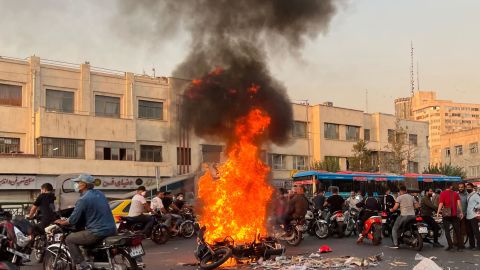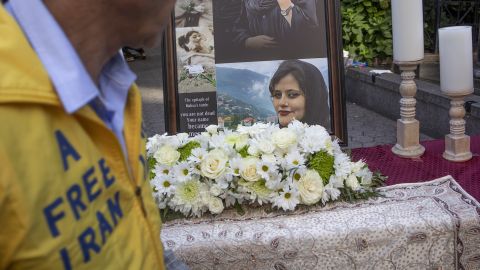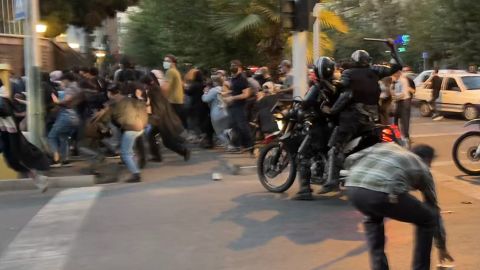[ad_1]
CNN
—
Nearly a month after the start of nationwide protests, parts of Iran now bear the hallmarks of battle zones, with flares lighting up skies, gunfire ringing out and bloody scenes recorded in video footage.
“I am recording this video about the situation in Sanandaj,” said one demonstrator, his face covered with a black scarf and dark glasses, in a message to CNN from the Kurdish-majority city in western Iran, where some of the most dramatic images have emerged from the protests, despite a near total internet shutdown in the area.
“Last night, the security forces were firing in the direction of houses. They were using military-grade bullets,” he said. “Until now, I hadn’t heard such bullets. People were really afraid.”
Video apparently shot from rooftops showed what appeared to be clashes between young protesters and heavily armed security forces. Bullets and flares crossed the night sky and a cloud of dust and smoke covered the city blocks.
At street level, other videos showed protesters throwing rocks at police, with the officers sometimes traveling in a procession of motorcycles, who appeared to be shooting at the crowd.
Large numbers of Iran’s elite Revolutionary Guards have been participating in the crackdown in addition to local police, say activists in Sanandaj, who accuse authorities of lashing back indiscriminately. According to Oslo-based Kurdish rights group Hengaw, a 7-year-old boy died in his mother’s arms on Sunday after security forces fired into a crowd of protesters.
While it is impossible to independently verify a death toll from such clashes, gruesome images circulating online, and eyewitness testimony collected by CNN as well as rights groups, point to the bloodshed. Video showed a driver in the city lying dead with a large gunshot wound in his face – activists said he was honking his horn in solidarity with protesters.

“In Sanandaj, they shoot the people honking their horns with bullets. And they shoot young and old alike,” said another protester in a video message to CNN. “The injured don’t go to hospitals because if they go there plain-clothes police will arrest them.
“We are protesting for freedom in Iran. For the prisoners and the condemned, for the people of Iran calling for the regime to go. Everyone wants this regime to go.”
Despite the government’s repeated claims of having restored calm, the scenes are being replicated throughout the country to varying degrees, with the Kurdish-majority west of the country appearing to bear the brunt of the crackdown.
In remarkable defiance, Iranian people keep pouring into thoroughfares across the country. The protests were first ignited by the death of 22-year-old Mahsa Amini (also known as Zhina), who died nearly one month ago after being detained by the country’s morality police, but demonstrators have since coalesced around a range of grievances with the regime. Increasingly, activists and experts are characterizing the protests as a national uprising.
“This is not a protest for reform,” Roham Alvandi, an associate professor of History at the London School of Economics, told CNN. “This is an uprising demanding the end of the Islamic Republic. And that is something completely different to what we’ve seen before.”

In the last month, Iran’s protesters have targeted the economic and political nerve centers of the regime. Videos showed people throwing rocks at police in the center of Tehran. In the capital’s bazaar, security forces were seen running away from demonstrators. Even in the conservative cities of Mashhad and Qom – the heart of the regime’s powerbase – demonstrators crop up frequently.
Some gas and oil refineries have also turned into sites of protests, which are rapidly spreading in the country’s southwest. The country’s Council of Oil Contractor Workers has said it would potentially call a strike and pause oil production.
The petroleum industry is the lifeline of Iran’s economy, which has been buckling under the strain of US sanctions unleashed by the Trump administration in 2018 and sustained by the Biden administration. US officials have been in indirect negotiations with Iran for a year and a half in a bid to restore a landmark 2015 nuclear deal – which former President Donald Trump withdrew from four years ago – that would see Iran curb its uranium enrichment program in exchange for sanctions relief.
Video suggested that the demonstrations at the refineries began as protests over wages, but then transformed into anti-regime protests, with laborers chanting “death to the dictator” – a reference to Supreme Leader Ayatollah Ali Khamenei.
Around the country, protesters have pushing for economic strikes with some success. In Kurdish-majority areas, where the protests are believed to be more organized than elsewhere in the country, social media videos showed lines of shops shuttered. In Tehran’s bazaar, a number of stores have closed in recent days, though many merchants say they did so to protect their shops from the protests and the crackdowns that follow. A general strike, which Iranian activists have called for, has yet to materialize.
Labor strikes are loaded with historic meaning in Iran. In 1979, oil and gas refineries played a critical role in the popular movement that overthrew the pro-Western Shah Mohammad Reza Pahlavi and paved the way for the Islamic Republic.
More widespread protest action by workers and merchants, experts say, could mark another escalation in the protests.
“If there is a nationwide general strike, what can the government do really,” said Alvandi. “That would completely paralyze the state and would show the powerlessness of the state in the face of this movement.”
Meanwhile, the crackdown continues to intensify in various parts of Iran, most notably in the Kurdish-majority north and northwest, where allegations of the mistreatment of the ethnic minority was already widespread.

Hengaw, the Kurdish rights group, believes that the violence against protesters being reported from the region “is just a drop in the ocean,” with only partial information emerging about the crackdown.
Authorities have sporadically shut down the internet across Iran in an apparent bid to quash the protests, with the Kurdish-majority parts of the country experiencing the longest shutdowns, according to activists and the internet watchdog NetBlocks.
A “major disruption” to internet access has occurred since 9:30 a.m. in Iran (2 a.m. ET) on Wednesday, according to NetBlocks. Kurdish activists say that authorities have also shut the area’s landline network, arguing that the bloodshed seen in the videos could just be the tip of the iceberg.
“The Iranian regime and its security apparatus has no limit,” said Remyar Hassani of Hengaw. “They know no limits.”
Source link



